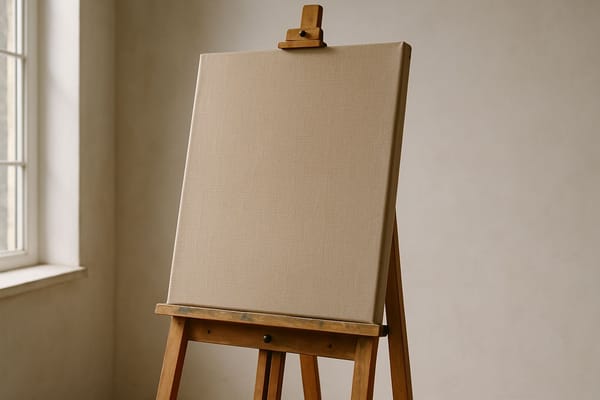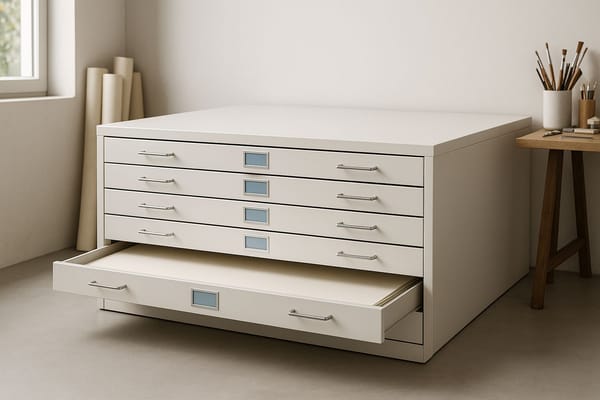Artist Easels 101: How to Choose the Right Easel for Your Medium, Space, and Budget
Find the perfect easel for your art style, space, and budget. Learn how to choose between studio, tabletop, and plein air easels in this guide.
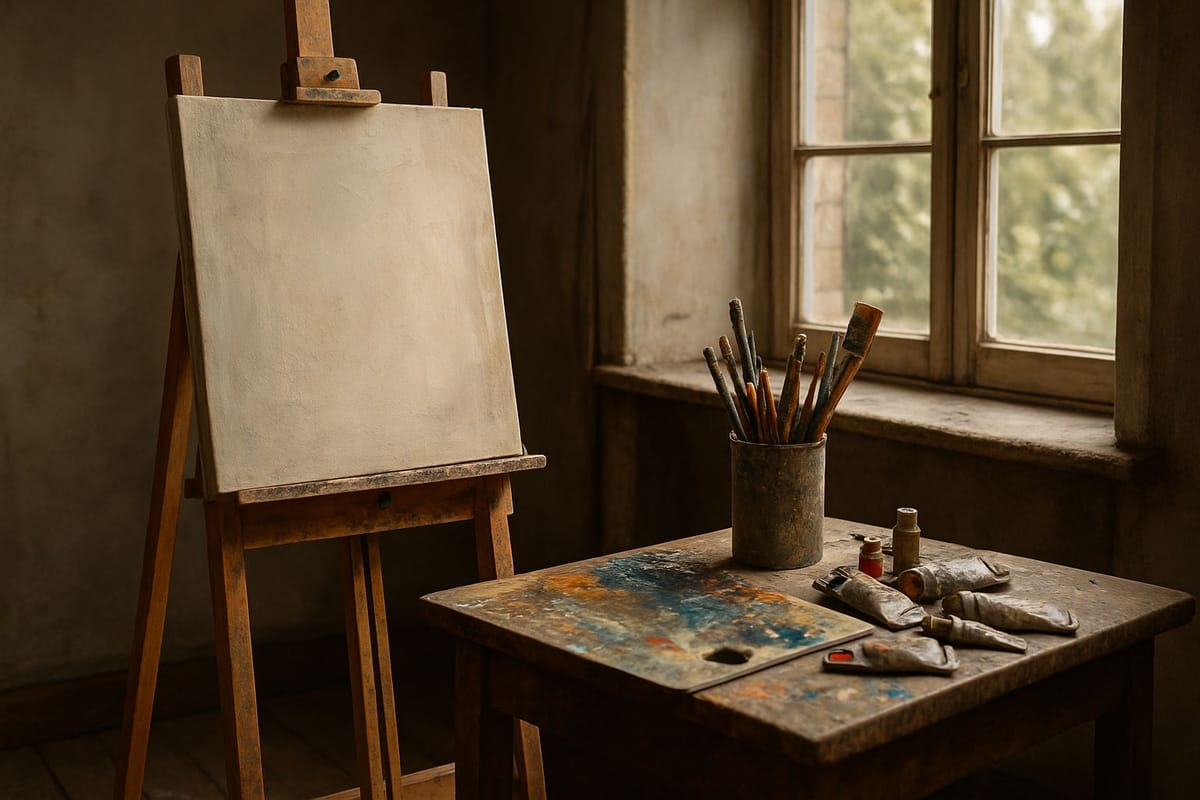
Choosing an easel shouldn't feel confusing. The right stand supports your posture, keeps your surface steady, and suits how and where you paint. This guide breaks down key types, features, and budget ranges so students, hobbyists, and pros can pick with confidence. Moreover, you'll see practical comparisons and a clear checklist to help you move from browsing to painting without second-guessing.
What Is an Artist's Easel and Why Does It Matter for Painters?
An easel is a stand that holds your surface upright or at an angle while you work to stabilize your canvas or board. It also sets the viewing angle, allowing you to judge proportion, colour, and value accurately in painting and drawing.
Good posture begins with adjusting your height and tilt, which can be done quickly. Therefore, steady support reduces arm strain and helps you paint with cleaner, more precise edges. It also keeps your tools and surface in a comfortable reach, so sessions feel focused, not fussy.
Pick the wrong stand and you'll fight wobble, glare, or awkward reach. The right choice supports your medium and scale, so brushstrokes land where you intend them to. Over time, a better fit leads to better consistency and, ultimately, better results.
What Are the Main Types of Artist Easels?
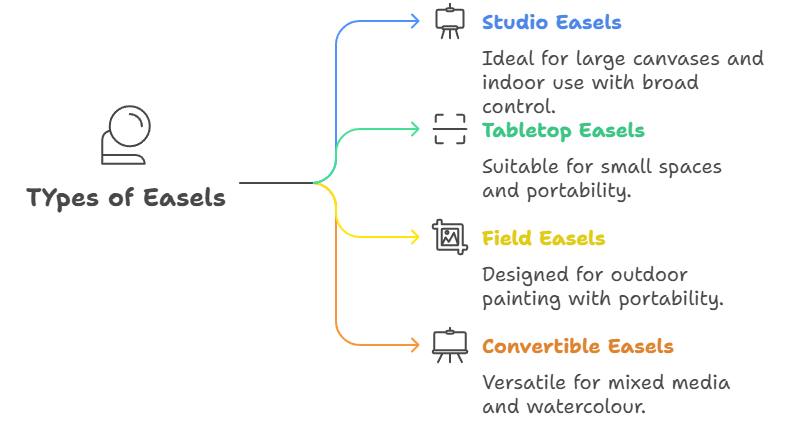
Most easels fall into the following categories: studio, tabletop, field/plein air, and convertible/hybrid. Each suits a different space, canvas size, and working style. Knowing the trade-offs makes it easy to shortlist what fits your practice.
Studio Easels
These are large, floor-standing frames for indoor use. They hold large canvases, stay in place, and offer broad height and angle control.
- Pros: Highly stable; works with big and heavy surfaces.
- Cons: Needs floor space; heavier to move
Tabletop easels
Shawneck-sized stands can be placed on a desk or dining table.
- Pros: Small footprint; light and affordable
- Cons: Limited canvas size; depends on table height
Field or plein-air easels
Constructed tripod, portable, or French-box designs intended to be used outdoors in painting.
- Pros: Lightweight and quick to set up; packs flat
- Cons: Less stable in wind; smaller weight capacity
Convertible and hybrid easels
Tilt from vertical to near-flat for mixed media and watercolour.
- Pros: Works for many media; wide-angle range
- Cons: Costs more; mechanisms add weight
How Do I Choose the Right Easel Based on My Painting Medium?
The right easel for any medium emerges from how paints behave, the angles they demand, and the sizes and weights your surfaces typically reach. Oils tend to thrive on rigid, vertical support, while acrylics benefit from quick angle adjustments. But watercolour generally prefers shallow tilt or near-flat positions to control washes.
Best easels for oil painting
Look for a rigid H-frame with strong clamps and a counterbalanced height, as oils favour rigid frames with wide stances and strong locks, which limit flex and vibration on larger canvases. Vertical work minimizes dust and sagging. Mabef M/04 or Blick Studio H-Frame handles heavy canvases well.
Best easels for acrylics
Acrylics dry quickly, so quick angle changes are helpful. Pick a stable studio or aluminum field model with easy tilt and a brush shelf. The Blick Studio H-Frame or Blick Aluminum Field Easel are dependable options.
Best easels for watercolour
Choose a convertible that tilts low or lies nearly flat to control washes. Side clips and a lip help keep boards steady. A Mabef Convertible or a sturdy tabletop drafting easel works nicely.
Universal options for artists
If you work with multiple media, consider a hybrid with a smooth tilt, secure canvas lock, and broad base. Blick Convertible H-Frame balances range, strength, and value for mixed workflows.
What Should I Consider When Choosing a Studio Space for My Easel?
You should consider the following space factors when selecting an easel: studio size, ceiling height, access paths, lighting, ventilation, floor type, and storage. Moreover, accurate measurements prevent wobbles, head bumps, and blocked doors. A quick floor plan clarifies the footprint, viewing distance, and storage space.
If you work seated, ensure you are in the lowest comfortable position. If you stand, ensure you have full reach at the top of your canvas without having to tiptoe. Leave clearance to step back several feet for judging values.
- Measure the max footprint; leave room to walk around.
- Confirm ceiling height for mast extensions and big canvases.
- Plan a parking spot when not in use or during the drying process.
- Check floor type; add pads or casters for smooth moves.
- Evaluate light direction to reduce glare and shadows.
What Are the Key Features to Look for in a Quality Easel?
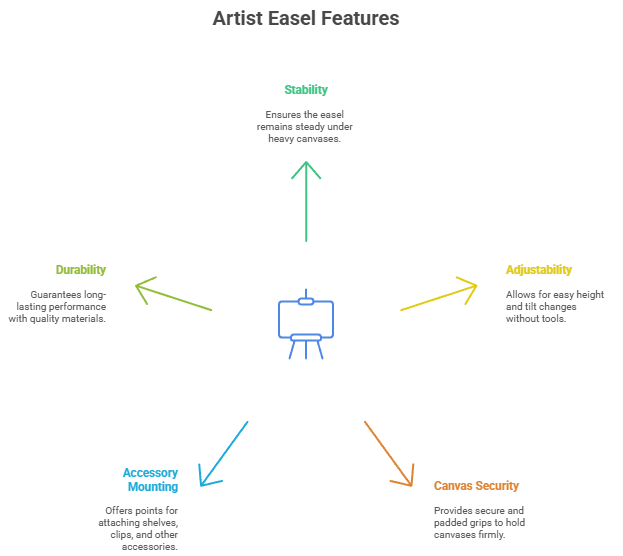
Key features of a quality easel include stability, smooth height and tilt control, and secure canvas grips that protect surfaces during vigorous work. A broad base and reliable locks matter more than extras. Comfort details, such as shelves, clips, and tidy tool management, keep attention focused on painting.
Height and angle adjustments for comfort and control
Look for single-handed knobs or crank lifts that can be adjusted mid-session. Fine tilt lets you control drips, glare, and perspective. A wide-angle range supports glazing, scumbling, and wash work.
Canvas holding mechanisms and weight capacity
Deep, rubberized jaws protect frames and panels. Rated capacity should exceed your largest planned surface. Crossbars and center posts that don't flex keep strokes crisp.
Storage trays, clips, and attachments that make painting easier
A sliding tool shelf holds brushes, knives, and a rag. Clips secure backing boards and reference. Hooks or side arms keep palettes and solvent cups within reach.
How Much Should You Spend on an Artist's Easel?
When spending on an easel, consider the size of the canvas, session frequency, and future objectives. Also, weigh the trade-off between stability and flexibility, focusing on features you will actually use. Professionals gain long-term value from precise mechanisms, stronger materials, and reliable hardware.
Entry-level options for students and hobbyists
There are light aluminum tripods and plain tabletops, which keep prices down. They excel at learning and performing menial tasks. Blick Tabletop Easel and Blick Aluminum Field Easel are affordable products.
Mid-range picks balancing quality and price
Sturdier H-frames with better locks and shelves offer clear upgrades. Expect better stability and smoother tilt. Blick Studio H-Frame delivers strong value for frequent use.
Professional-grade easels built for longevity and precision
Heavy hardwood frames with counterweights and fine hardware excel in daily studio work. They handle large canvases and maintain their square shape. Mabef studio models are a trusted standard.
How Do You Set Up, Use, and Maintain an Artist's Easel?
You must assemble on a flat surface, tighten all hardware, and test movement before a live session. Keep tools handy and adjust height to your eyes, not the other way around.
- Unbox, sort parts, and follow the diagram step by step.
- Level the feet, then tighten cross braces and mast knobs.
- Set the working height so the canvas center meets your eye line.
- Adjust tilt to control drips, glare, and shoulder comfort.
- Add tray, clips, and a waste rag; test with a scrap board.
- Wipe paint off clamps, re-tighten hardware monthly, and wax wood rails lightly.
Which Artist Easel Should You Choose? (Final Buying Checklist)
The right easel aligns with your space, medium, and budget, meeting stability, capacity, and tilt needs for the canvas sizes you actually use. Shortlist models that fit your room and reach. Choose the best blend of comfort, control, and value for every session.
Matching your easel to your space, medium, and budget
Small rooms and small panels favour tabletop or compact tripods. Large oils call for an H-frame. Mixed-media artists benefit from a convertible with firm locks and a wide tilt range.
Must-check features before buying
- Base width and overall stability under load
- Smooth, tool-free height and tilt adjustments
- Secure, padded canvas grips and rated capacity
- Shelf, clips, and accessory mounting points
- Materials and hardware built for long service
Final Take
The best stand disappears under your hands. Choose stable construction, easy adjustments, and grips that fit your surfaces. Add the features you'll use every session, and you'll spend more time painting and less time wrestling with your setup.
Frequently Asked Questions
What’s the Best Easel for Beginners?
A sturdy tabletop or light H frame that fits your space and budget. Simple knobs, a small shelf, and a wide, rubber-footed base help.
Can I Use One Easel for Both Oil and Watercolour?
Yes. A convertible model that tilts from vertical to near flat handles washes and thick paint well. Board clips add control.
How Tall Should My Easel Be for Comfortable Use?
Canvas center near eye level. You should reach the top without stretching, with relaxed shoulders, whether seated or standing.
Are Portable Easels Stable Enough for Large Canvases?
Fine for small to medium work. For big, heavy panels, choose a studio H frame with a wider base and stronger locks.
How Do I Prevent My Easel From Wobbling While Painting?
Widen the stance, level the feet, and tighten all knobs. Add floor pads, lower the mast, brace the crossbar, or reduce canvas height.


